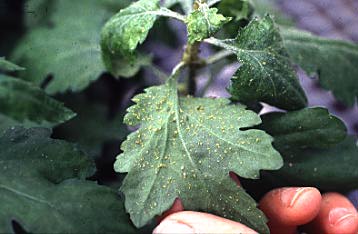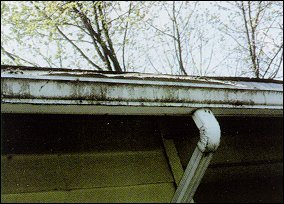
Fig. 1
Horticultural Oil Spray
Controls aphids, mites,galls, mealy bugs, and other
insects. Kills insects by blocking their pores and smothering them.
Aphid & Whitefly Trap
is another
simple and economical way to get rid of aphids, whiteflies and other
small insects in your garden
Predator Insects
Green Lacewings all-purpose predator! Gorges on an immense number of soft-bodied pests, mites, insect eggs.
Ladybugs Lady Beetles and their larvae consume huge amounts of Aphids, as many as 2400 in their lifespan.
Praying Mantids Praying Mantids are a voracious eating machine and a general predator of most pest insects including mites, insect eggs, aphids and just about anything within reach, they do not eat plants and are strict carnivores.

Fig. 2
Aphid control/prevention is most important for new plantings, where sap removal by aphids is most likely to affect the plants development.
Established and otherwise healthy plants can tolerate moderate aphid infestations, although affected leaves may wilt and turn yellow and there may be some premature drop.Early detection is the key to reducing aphid infestations. The flight of winged colonizers cannot be predicted, so frequent examination of plants will help to determine the need for control. Watch for buildup of colonies of aphids on the undersides of the leaves (Fig.1 above) . Also look for the appearance of Sooty Mold or " Honey Dew" anywhere in proximity to your Yard or Garden. Aphids as well as mealy bugs ,whitefly, and several other sap sucking insects produce a sugary liquid waste called "honeydew".
A fungus called sooty mold may grow on honeydew deposits that accumulate on leaves and branches, turning them black. The appearance of sooty mold on plants may be the first time that an aphid infestation is noticed .
Sooty mold is a dark gray to black fungus that appears as a coating on the surface of leaves, fruits, twigs and branches, as well as any structures as shown above . This fungus is not pathogenic to plants but obtains its nourishment from insect honeydew.
Common sense dictates that to
prevent sooty mold, you must control the insects.
Remember -- look for insects not only on the affected plants,
but over head plants as well for infestation when sooty mold
appears.
In most cases sooty-mold can be dispersed with a
strong water spray, but the insect infestation that lead to it
is still to be addressed.
In annuals, Problems with honeydew and sooty mold may develop
but tend to be temporary and disappear along with the aphids
Some aphid species generate distorted leaves; But this is only a
concern for esthetic appeal. The leaves will remain cupped and
twisted until they fall off. Insecticide
applications often are less effective because the aphids are
protected in the gnarled leaves.
References